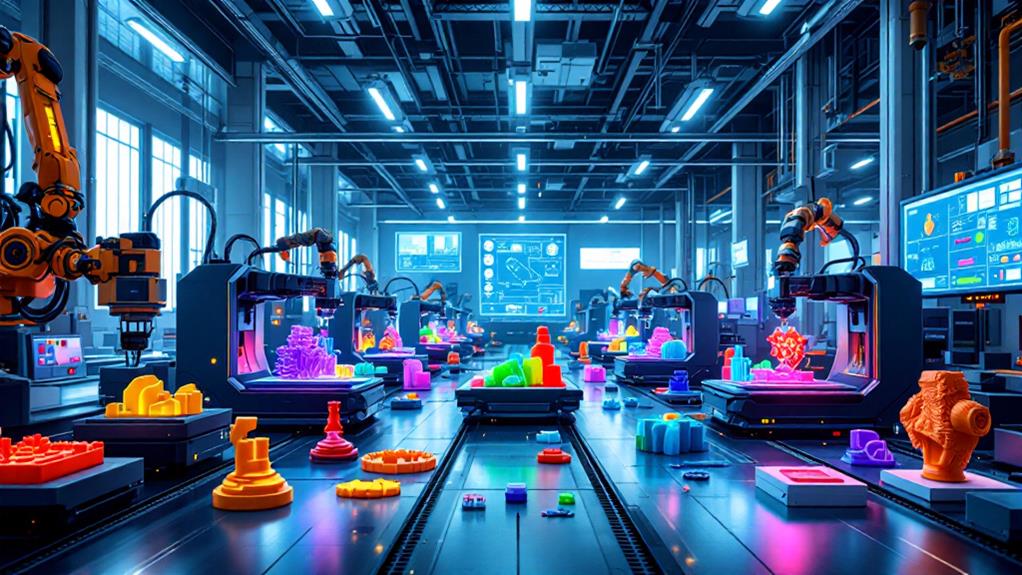What Is the Space Elevator? A Vision for the Future of Space Travel

Imagine a massive tether stretching from Earth's surface into space; that's the space elevator, a radical shift in accessing the cosmos. This concept, initially proposed over a century ago, offers a cost-effective, environmentally friendly alternative to rocket launches. With the tether made from ultra-strong materials like carbon nanotubes, climbers powered by electric propulsion can ascend to orbit. This could revolutionize how you approach space travel, from reducing costs to facilitating international cooperation. Investigate the complexities and potential that make the space elevator not just a dream of science fiction but a viable future innovation.
Origins of the Space Elevator
The concept of the space elevator, long a staple of science fiction, initially sprouted from the imaginative minds of Russian scientist Konstantin Tsiolkovsky in 1895. Inspired by the Eiffel Tower, Tsiolkovsky envisioned a tower reaching from the Earth into space, allowing for easy access beyond our atmosphere. This visionary concept was groundbreaking, considering the historical context of that period. It was a time when the idea of space travel was merely a dream in the minds of only the most daring thinkers.
You can trace the evolution of the space elevator concept through the decades. During the mid-20th century, science fiction authors like Arthur C. Clarke further popularized it. Clarke's works often investigated how humanity could utilize such structures to revolutionize space travel. This speculative yet visionary thinking inspired scientists and engineers to seriously consider the feasibility of building a space elevator.
Fast forward to the 21st century, and the concept is not just a fantastical dream. Modern technological advancements have brought Tsiolkovsky's visionary concepts closer to reality. As you probe deeper into the origins, you'll see how the space elevator represents humanity's relentless quest for innovation and discovery.
How the Space Elevator Works
Envisioning a space elevator involves understanding both its groundbreaking simplicity and complex engineering. Picture a giant tether stretching from the Earth's surface to a counterweight in space. This tether acts as a pathway for a climber, or elevator car, to transport materials and possibly people. The key lies in tether dynamics, where the tension and motion of the cable are precisely managed to maintain stability and functionality.
You'll find that orbital mechanics play a vital role in this process. The counterweight at the tether's end remains in a geostationary orbit, meaning it stays directly above a fixed point on Earth. This balance guarantees the tether remains taut, allowing the elevator to travel smoothly up and down. The motion of the Earth and the counterweight's orbit work in harmony, creating a stable, reliable system.
To operate, the space elevator uses a combination of electric and magnetic propulsion systems, which propel the climber along the tether. With no need for traditional rocket launches, you're looking at a more sustainable and cost-effective way to access space. This inventive approach could revolutionize space travel, making it more accessible than ever before.
The Science Behind the Tether

Frequently overlooked yet absolutely vital, the tether in a space elevator stands at the heart of its engineering marvel. It's more than just a cable; it's a feat of extraordinary science and precision. You might wonder how it all works. Well, the tether dynamics and gravitational balance play significant roles in making this concept a reality. Let's break it down:
- Tether Dynamics: The tether needs to withstand immense forces as it stretches from Earth's surface to space. It must be incredibly strong yet lightweight.
- Gravitational Balance: The tether must maintain equilibrium between Earth's gravity pulling it down and the centrifugal force from Earth's rotation pulling it outward.
- Geostationary Anchor: To stay balanced, one end of the tether connects to a platform in geostationary orbit, ensuring it moves in sync with Earth's rotation.
- Counterweight: At the tether's far end, a counterweight beyond geostationary orbit helps maintain the tension needed for stability.
You see, the science behind the tether is a dance of forces and balance, ensuring the structure remains taut and functional. It's a brilliant, intricate design that's critical to the future of space travel.
Materials Needed for Construction
When considering the construction of a space elevator, selecting the right materials is vital for its success. You'll need to focus on materials with exceptional tensile strength, and carbon nanotubes are at the forefront of this search. These materials are incredibly strong and lightweight, making them ideal for the elevator's tether. However, integrating them into construction techniques demands careful planning and precision.
Safety considerations are paramount. You must guarantee that the materials can withstand environmental stresses, such as space debris and extreme temperatures. Furthermore, you'll have to take the environmental impact into account. The production process of carbon nanotubes should minimize harm to the environment while maintaining efficiency.
Cost estimation is another key factor. While carbon nanotubes offer significant advantages, they come with high costs. Evaluating the balance between cost and performance will guide your decisions. Design specifications must be precise, guaranteeing that every aspect of the space elevator fits together seamlessly.
Material sourcing is similarly important. You'll need reliable suppliers who can provide consistent quality and quantity. Building a space elevator is no small feat, but with the right materials and planning, it's within reach.
Potential Benefits of Space Elevators

A space elevator could revolutionize space travel by greatly reducing the cost and energy required to transport materials and people into orbit. Imagine launching payloads without the need for expensive rocket fuel or dealing with the environmental impact of rocket launches. This innovation promises to make space more accessible and sustainable. Here's how you'd benefit from this groundbreaking technology:
- Cost Efficiency: Space elevators could lower the price per kilogram to orbit, making space travel affordable for more countries and organizations.
- Environmental Impact: By reducing dependence on rocket launches, space elevators could considerably cut down on the pollution and carbon emissions associated with traditional space travel.
- International Collaboration: Building and operating a space elevator would require global cooperation, fostering partnerships between countries and encouraging shared technological advancements.
- Continuous Access: Unlike rockets, which are limited by launch windows and weather conditions, space elevators would provide a constant pathway to space, allowing for more frequent and reliable trips.
Challenges and Obstacles
Despite its potential, the concept of a space elevator faces significant challenges and obstacles that can't be overlooked. Initially, the technical limitations are intimidating. Constructing a tether strong enough to stretch thousands of kilometers into space demands materials that currently push the boundaries of engineering feasibility. These materials must withstand immense stress, radiation, and space debris impacts.
Funding challenges can't be ignored either. Developing such groundbreaking technology requires substantial financial investment, and convincing stakeholders to fund a project with uncertain returns is no small feat. Safety concerns also loom large. A failure in the system could lead to catastrophic consequences, raising questions about risk management and emergency protocols.
Public perception plays a vital role in advancing the space elevator concept. Many might view it as science fiction rather than a viable project, which can stifle support and enthusiasm. Regulatory hurdles add another layer of complexity, as international laws governing space activities need to be navigated carefully.
The environmental impact of constructing and maintaining a space elevator is another concern. It's important to assess how it would affect Earth's ecosystems. International collaboration will be significant in addressing these obstacles, but fostering cooperation among nations isn't always straightforward.
Current Research and Developments

While the challenges and obstacles of building a space elevator are intimidating, groundbreaking research and technological advancements are making headway in turning this ambitious concept into reality. Organizations and scientists worldwide are investigating current innovations and advanced technologies to overcome these hurdles. Here's a glimpse into the exciting developments:
- Material Science: Engineers are focusing on creating ultra-strong materials, like carbon nanotubes and graphene, to construct the elevator's tether. These materials promise the necessary strength-to-weight ratio required for a structure that stretches from Earth to space.
- Robotics: Advances in robotics are essential for developing automated climbers that can transport cargo and people along the tether. These robots need to be reliable, efficient, and capable of operating in the harsh conditions of space.
- Anchor Points: Research is underway to identify and develop stable anchor points on Earth and in space. These must withstand immense forces and provide a secure foundation for the elevator's operations.
- Energy Systems: Creative energy solutions, such as solar power and wireless energy transmission, are being examined to power the space elevator's components sustainably.
These developments are bringing the dream of a space elevator closer to reality, setting the stage for a transformative future in space travel.
Economic Implications
Beyond the technological marvels, the economic implications of constructing a space elevator are profound and far-reaching. Imagine a world where launching payloads into space is considerably cheaper. The space elevator promises unparalleled cost efficiency. Traditional rocket launches are expensive, limiting access to space to only the wealthiest nations and companies. However, a space elevator could drastically reduce these costs, making space more accessible to a wider array of participants.
With lower costs, new investment opportunities would arise. Industries that rely on space-based operations—like satellite communications, space tourism, and research—could flourish. You'd see a surge in startups and established companies enthusiastic to capitalize on this newfound affordability. As a result, the space industry could become a major contributor to the global economy, driving innovation and creating jobs.
Investing in the space elevator's construction and maintenance could yield substantial returns. Governments and private entities would likely form partnerships, pooling resources for mutual benefit. The economic ripple effect would extend beyond the space sector, potentially enhancing related fields like materials science and robotics. By embracing the space elevator, you contribute to a future where the sky isn't the limit; it's just the beginning.
Impact on Space Exploration

How might a space elevator transform our approach to space exploration? Imagine a future where reaching the stars isn't just a dream but a practical reality. A space elevator could revolutionize space travel by providing a reliable and cost-effective means to transport materials and people beyond Earth's atmosphere. Here's how it could impact space exploration:
- Reduced Costs: By reducing the need for expensive rocket launches, space elevators can lower the financial barriers, making space exploration more accessible.
- Increased Frequency: With easier access, missions to space could become more frequent, accelerating technological advancements in space equipment and exploration techniques.
- Collaboration Opportunities: The construction and operation of a space elevator would necessitate international collaboration, fostering global partnerships and sharing of resources and expertise.
- Sustainability: By offering a reusable method of reaching space, space elevators can minimize environmental impact, supporting sustainable exploration practices.
With these benefits, a space elevator could greatly improve humanity's ability to investigate space, making the vast universe more reachable than ever before. Embracing such technological advancements could open new doors, inspiring future generations to look beyond our planet and into the cosmos.
Future Possibilities and Innovations
The transformative potential of a space elevator on space exploration opens the door to exciting future possibilities and innovations. Imagine launching satellites and spacecraft without the massive energy costs of rockets. By using sustainable energy sources like solar power, a space elevator could drastically reduce the carbon footprint of space travel. This approach not only aligns with global environmental goals but also makes space more accessible and affordable.
You'd also see a surge in international collaboration. Building and maintaining a space elevator requires the combined expertise and resources of multiple countries. This cooperation could foster stronger global partnerships and shared technological advancements. By working together, nations can overcome the complex engineering challenges and share the benefits of such a monumental project.
Moreover, a space elevator could serve as a launchpad for deeper space exploration, opening new frontiers for scientific research and commercial endeavors. You could witness a new epoch where space tourism becomes commonplace, or asteroid mining becomes a viable industry. The innovations born from this project could transform our understanding of space travel, making it an integral part of human advancement and exploration.



